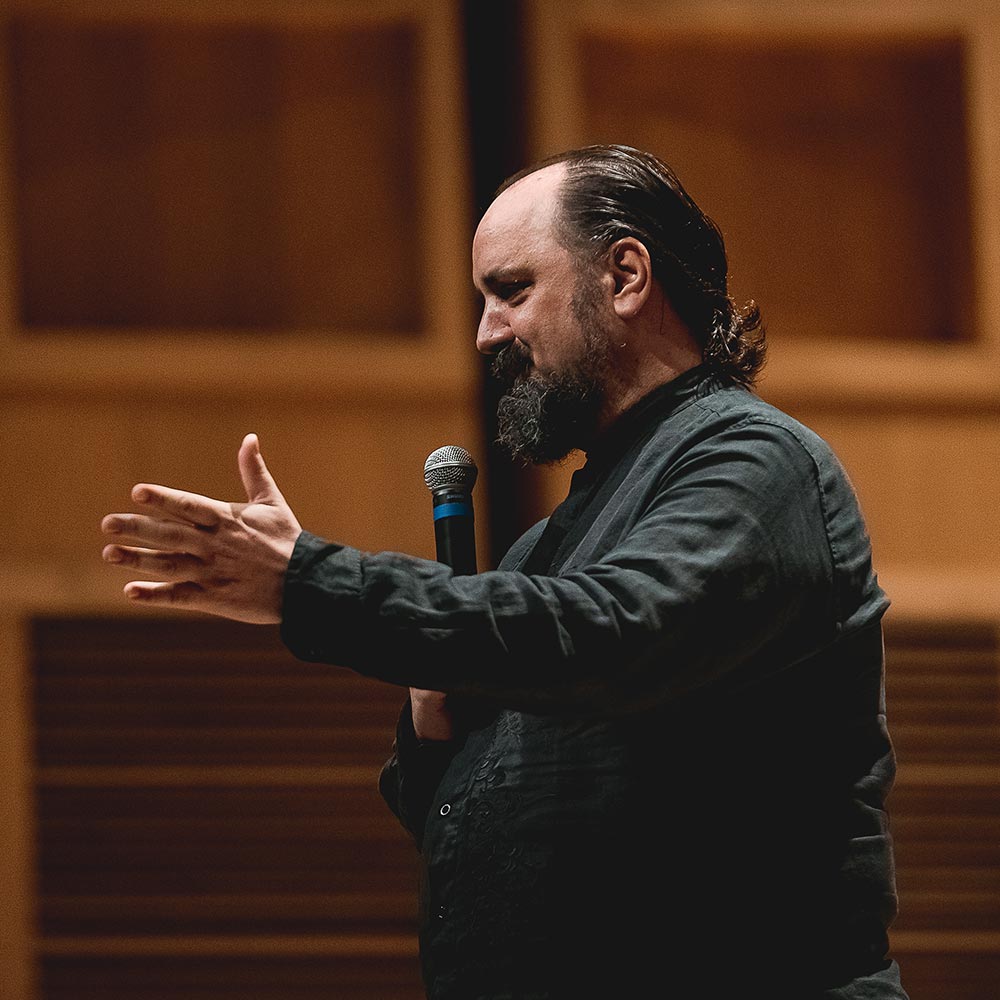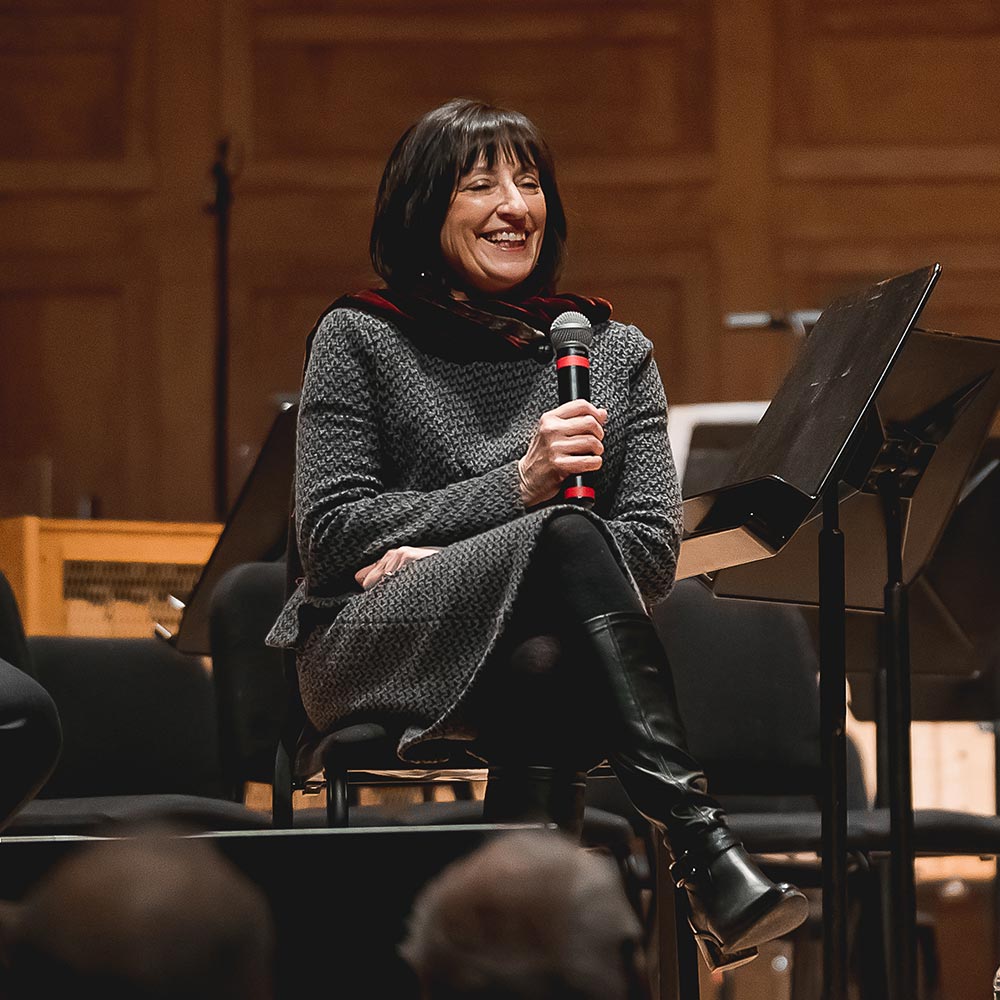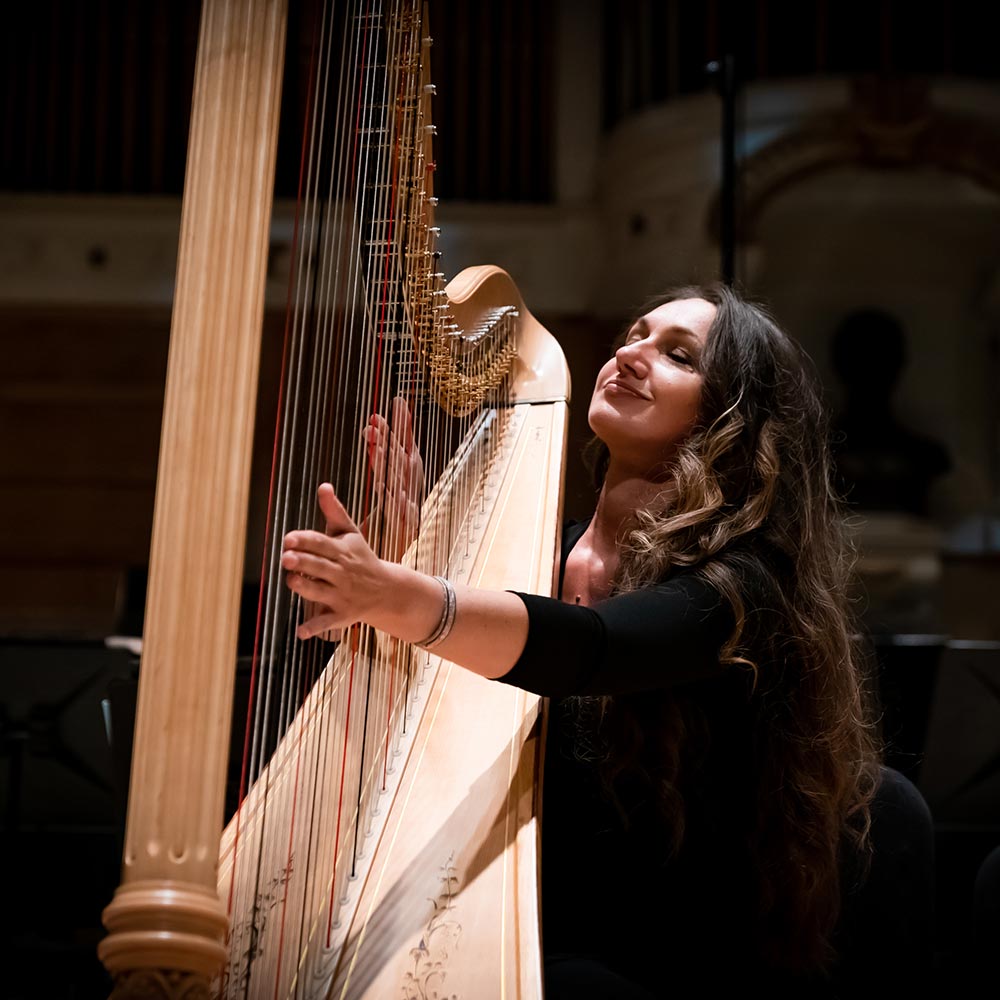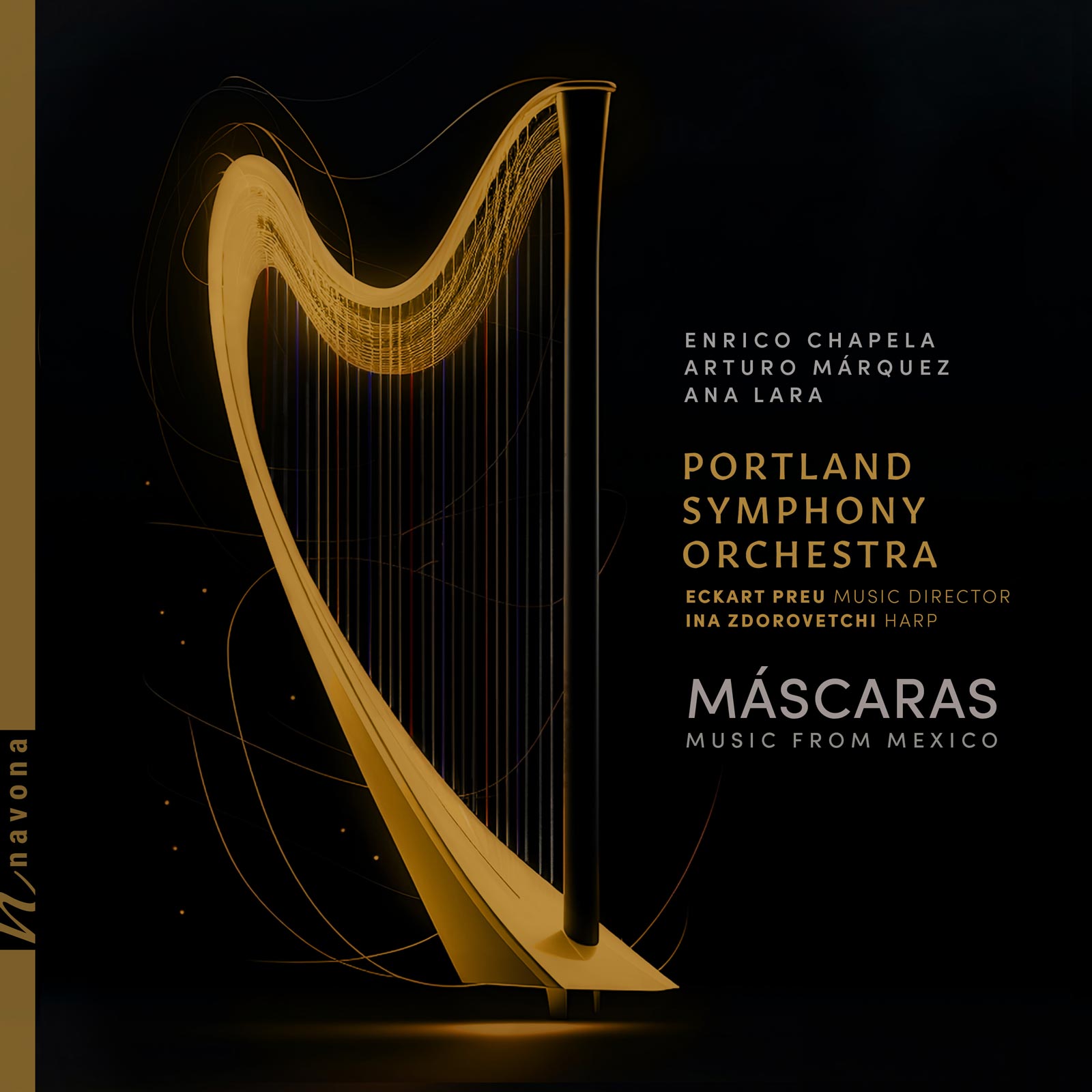Máscaras
Enrico Chapela composer
Arturo Márquez composer
Ana Lara composer
Portland Symphony Orchestra
Eckart Preu Music Director
Ina Zdorovetchi harp
Produced with audio captured from two live concerts held at Merrill Auditorium in Portland ME, the Portland Symphony Orchestra presents a world-class recordi
The PSO makes their opening statement with a newly-revised version of Enrico Chapela’s 2017 work Rotor, an intense rhythmic etude, followed by Arturo Márquez’s Máscaras, a concerto for harp and orchestra inspired by ancient pre-Hispanic Mexican tradition. Ángeles de Llama y Hielo by Ana Lara follows suit, a nod to a 16th century German woodcut print and the cosmological philosophy that inspired it. Polished, authentic, and strong, the performances on MÁSCARAS reflect the Portland Symphony Orchestra’s rich musical energy and commitment to ever broadening its horizons.
Listen
Stream/Buy
Choose your platform
Track Listing & Credits
| # | Title | Composer | Performer | |
|---|---|---|---|---|
| 01 | Rotor | Enrico Chapela | Portland Symphony Orchestra | Eckart Preu, music director | 11:33 |
| 02 | Máscaras: Concerto for Harp and Orchestra: I. Máscara Flor | Arturo Márquez | Ina Zdorovetchi, harp; Portland Symphony Orchestra | Eckart Preu, music director | 6:17 |
| 03 | Máscaras: Concerto for Harp and Orchestra: II. Máscara Son | Arturo Márquez | Ina Zdorovetchi, harp; Portland Symphony Orchestra | Eckart Preu, music director | 7:44 |
| 04 | Máscaras: Concerto for Harp and Orchestra: III. La Pasión según San Juan de Letrán | Arturo Márquez | Ina Zdorovetchi, harp; Portland Symphony Orchestra | Eckart Preu, music director | 5:57 |
| 05 | Máscaras: Concerto for Harp and Orchestra: IV. La Pasión según Marcos | Arturo Márquez | Ina Zdorovetchi, harp; Portland Symphony Orchestra | Eckart Preu, music director | 4:39 |
| 06 | Ángeles de Llama y Hielo: I. Angel de Tinieblas | Ana Lara | Portland Symphony Orchestra | Eckart Preu, music director | 7:13 |
| 07 | Ángeles de Llama y Hielo: II. Angel del Alba | Ana Lara | Portland Symphony Orchestra | Eckart Preu, music director | 5:37 |
| 08 | Ángeles de Llama y Hielo: III. Angel de Luz | Ana Lara | Portland Symphony Orchestra | Eckart Preu, music director | 3:59 |
| 09 | Ángeles de Llama y Hielo: IV. Angel del Ocaso | Ana Lara | Portland Symphony Orchestra | Eckart Preu, music director | 4:34 |
Special thanks to the Horizon Foundation and Davis Family Foundation for supporting this project, and to Transparent Audio of Saco ME.
Recorded April 2 & 4, 2023 at Merrill Auditorium in Portland ME
Producer & Engineer Brad Michel
Editing, Mixing & Mastering Brad Michel
Executive Producer Bob Lord
VP of A&R Brandon MacNeil
A&R Chris Robinson
VP of Production Jan Košulič
Audio Director Lucas Paquette
Production Manager Martina Watzková
VP, Design & Marketing Brett Picknell
Art Director Ryan Harrison
Design Edward A. Fleming, Morgan Hauber
Publicity Aidan Curran
Digital Marketing Manager Brett Iannucci
Artist Information

Portland Symphony Orchestra
Founded in 1924 in Portland ME, the Portland Symphony Orchestra (PSO) has a long and illustrious history of bringing fine orchestral music to Maine and northern New England. It is an ongoing source of civic pride and artistic leadership, the largest performing arts organization in this city of 70,000 people. All volunteer at its start, the PSO now employs 83 professional musicians drawn from all six New England states. It performs nearly 40 concerts each season at Merrill Auditorium in Portland and at Seaside Pavilion in Old Orchard Beach. The PSO’s education and lifelong learning programs reach thousands of people across Maine every year, both in person and virtually.

Eckart Preu
Eckart Preu is the Music Director of the Portland Symphony Orchestra, the Long Beach Symphony Orchestra (CA), and the Cincinnati Chamber Orchestra (OH). Previously, he was the Music Director of the Spokane Symphony (WA) and the Stamford Symphony (CT), Associate Conductor of the Richmond Symphony (VA), and Resident Conductor of the American Symphony Orchestra and the American Russian Young Artists Orchestra. Also, Preu served as Music Director of the Orchestre International de Paris.

Enrico Chapela
Born in Mexico City in 1974, Enrico Chapela Barba studied guitar and composition at CIEM in Mexico and received a master’s degree at the University of Paris. In the last 20 years, he has obtained recognition in national and international composition competitions including The John Simon Guggenheim Memorial Foundation Fellowships, the National System of Art Creators, the UNESCO International Tribune of Composers, the Alexander Zemlinsky International Composition Competition, and The Barlow Endowment for Music Composition Prize.
Arturo Márquez
Born in Alamos, Mexico on December 20, 1950, Arturo Márquez grew up listening to his father perform traditional waltzes and polkas and was soon inspired to begin studying the violin and composition. By 1970 he was a student at the Mexican Music Conservatory, working with Joaquin Gutierrez Heras and Federico Ibarra. A scholarship from the French government brought him to Paris to study with Jacques Casterède; he concluded his studies with a master’s degree at the California Institute of the Arts on a Fulbright Scholarship.

Ana Lara
Ana Lara is a vital personality in Mexican contemporary music. She is highly regarded as a composer, promoter, and programmer. Lara has worked as artistic director of contemporary music at Festival Internacional Cervantino (2007-2009) and created the Festival Internacional Música y Escena, which she directed for 13 years (1998-2012). Since 1989 she has produced the program Hacia una nueva música at University Radio (Radio UNAM) which is devoted to contemporary music. Since 2015, together with Jean-Paul Bernard (former director of Les Percussions de Strasbourg), she has created Afinidades Insospechadas, a platform for interdisciplinary works based on collaboration and academic education. She was the Cultural Attachée at the Mexican Embassy in France, and the Director of the Instituto Cultural de Mexico in Paris from 2016-1017.

Ina Zdorovetchi
Ina Zdorovetchi is an American harpist of Eastern European descent. Over the past 25 years she has given hundreds of concerto performances, including many world/continental premieres. She has appeared with numerous orchestras around the world including The Boston Pops, Westdeutscher Rundfunk Sinfonieorchester Köln, Jerusalem Symphony, Haifa Symphony, Portland Symphony Orchestra, Long Beach Symphony, Boston Modern Orchestra Project, Cincinnati Chamber Orchestra, Seattle Chamber Orchestra, Brevard Music Center Orchestra, and many others. Highlights include giving the European Premiere of John Williams’ On Willows and Birches harp concerto, world premiere of Thomas Oboe Lee’s …bisbigliando… harp concerto (dedicated to her), and being featured as one of five soloists in the American Harp Society National Conference Gala Concert alongside some of the world’s most celebrated harpists.
Orchestra Members
FIRST VIOLINS
Charles Dimmick, Concertmaster
Amy Sims, Assistant Concertmaster
Susan Shipley
Holly Ovenden
Mina Lavcheva
Allyson Michal
Mark Paxson
Lisa Goddard
Xiao Fu
Mia Bella D’Augelli
Judith Lee
Courtney Cameron
Wilson Pedrazas
Jennifer Hillaker
SECOND VIOLINS
Sarah Atwood, Principal
Sasha Callahan, Assistant Principal (Christine M. Thornton Chair)
Antoaneta Anguelova
Deirdre Oehrtmann
Matthew Watras
Clorinda Noyes
Luis Antonio Ibáñez
Yasmin Craig Vitalius
Callie Brennan
David Parry
Lidija Peno-Kelly
Yeolim Nam
VIOLAS
Cara Pogossian, Principal (Sue & Hank Schmitt Chair)
Willine Thoe, Assistant Principal
Russell Wilson
Ann Stepp
Kimberly Lehmann
Harold Lieberman
Noriko Futagami
Sharon Bielik
Matthew Consul
VIOLONCELLOS
Sein Lee, Principal (Katherine Graffam Chair)
Brent Selby, Assistant Principal (W. Brian Thornton Chair)
William Rounds
James Kennedy
Barbara Paschke
Richard Noyes
David Paschke
Joel Wolfe
Leo Eguchi
CONTRABASSES
Joseph Holt, Principal
Brian Thacker, Assistant Principal
Anthony D’Amico
Margaret Metcalf
Nathan Varga
FLUTES
Lisa Hennessy, Principal
Alison Hale
Rachel Braude
PICCOLO
Rachel Braude
OBOES
Amanda Hardy, Principal (Clinton Graffam Chair)
Alessandro Cirafici
Julianne Verret
ENGLISH HORN
Julianne Verret
CLARINETS
Thomas Parchman, Principal
Jan Halloran
John Korajczyk
BASS CLARINET
John Korajczyk
BASSOONS
Janet Polk, Principal (Judith and Jeffrey Kane Chair)
Ardith Keef
Margaret Phillips
CONTRABASSOON
Margaret Phillips
HORNS
Lauren Winter, Principal
Kevin Owen
John Michael Flavetta
Nina Allen Miller
TRUMPETS
Joseph Foley, Principal
Elizabeth Rines
Dana Oakes
TROMBONES
Liam Glendening, Principal
Greg Spiridopoulos
Cameron Owen
Mark Manduca
BASS TROMBONE
Cameron Owen
TUBA
Don Rankin, Principal
TIMPANI
John Tanzer, Principal
PERCUSSION
Nancy Smith, Principal
Richard S. Kelly
Gregory Simonds
HARP
Ina Zdorovetchi, Principal
KEYBOARD
Vacant, Principal (Elizabeth Edney Nanovic Chair)
OPERATIONS
Eva Tartaglia, Director of Artistic Operations
Andrew Greene, Production Manager
Brian Shank, Librarian
Martin Webster, Personnel Manager
Carolyn Nishon, Executive Director
Notes
The word “record” has two meanings. It can be a noun—an account of the past. Or it can be a verb—to set down or convert sound in permanent form. For the Portland Symphony Orchestra, this commercial recording is also a record. A record of a century of artistic growth under the leadership of talented conductors and concertmasters, and a showcase of the artistry of our musicians.
On the heels of releasing this milestone project, the Portland Symphony will celebrate 100 years of performing for our community of Portland and Maine. These 100 years have brought incredible moments and some incredible challenges, including a pandemic that shuttered concert halls across the world.
But during those pandemic years, the PSO found a way to play on, developing a close connection with the internationally-recognized production house PARMA Recordings. With their help, we recorded and streamed concerts, continuing to serve our community through music. This recording is the culmination of this relationship, preserving their artistry for posterity.
When deciding which works to include in this project, the PSO used our commitment to diversify our repertoire as a guiding light. The three composers on this recording show the variety of the contemporary classical musical language of Mexico.
Enrico Chapela’s music is immediately identifiable. Fusing Mexican popular culture like the traditional danzón with modern popular musical styles such as classic rock, jazz, and electronic, his music projects percussive energy. Chapela’s Rotor was composed for large orchestra in 2017 and features the colorful playing, rhythmic precision, and energy of the PSO.
Arturo Márquez is probably the most known Mexican composer, hailing from a family of Mariachi and folk musicians. The sounds of the dance halls in Mexico City influenced Márquez’s rhythms, melodies, and harmonies. In this concerto for harp Máscaras (“Masks”), Arturo Márquez creates music that is uniquely appealing and full of color. Virtuoso harpist Ina Zdorovetchi has a multilateral career as a soloist and chamber musician. She is also the Principal harpist of the PSO, Boston Lyric Opera, and Boston Modern Orchestra Project. Representing the high-caliber talent in the ranks of the PSO, Zdorovetchi is a brilliant and virtuosic master of the instrument, tackling this most challenging of concertos for the harp.
Ana Lara is the major female composer in Mexico. Drawing from influences from her Mexican heritage, Bach, Penderecki, and Lutoslawski, she creates compelling soundscapes that will intrigue even the first- time listener. Her Ángeles de llama y hielo (“Angels of Flame and Ice”) evokes powerful images of four Angels (Darkness, Dawn, Light and Sunset) and goes to the very depths of the human condition.
With this recording we aim to enrich the musical landscape in the United States. American orchestras and conductors will benefit from this recording as a reference for future live performances. A commercial recording project is a monumental endeavor, and to succeed it takes the efforts of the entire orchestra organization. I am grateful to the full staff, as well as the committed board of the Portland Symphony, our loyal audience, the talent of our musicians, and our sound engineer, GRAMMY-award winning Brad Michel, for making this recording a reality.
— Eckart Preu, Music Director

